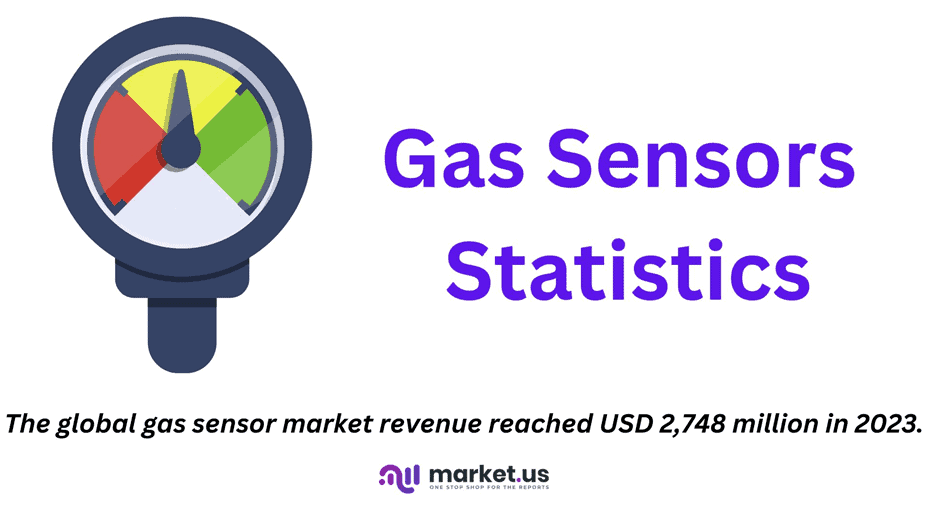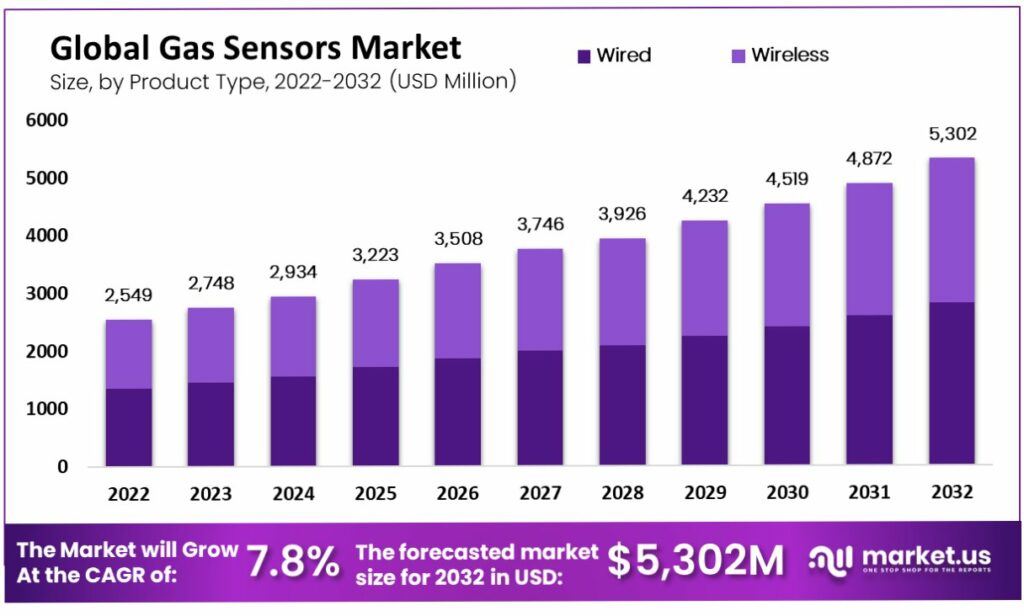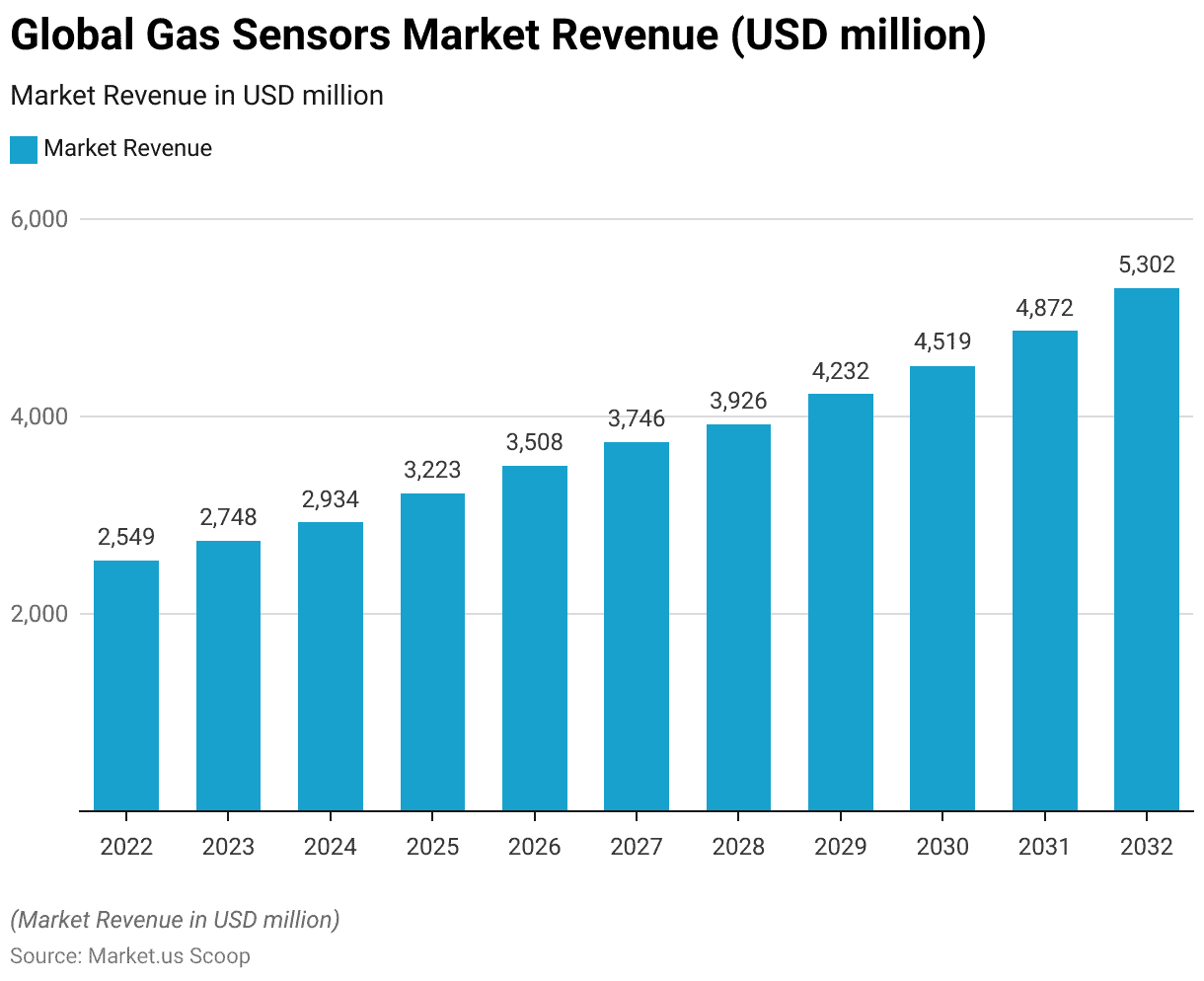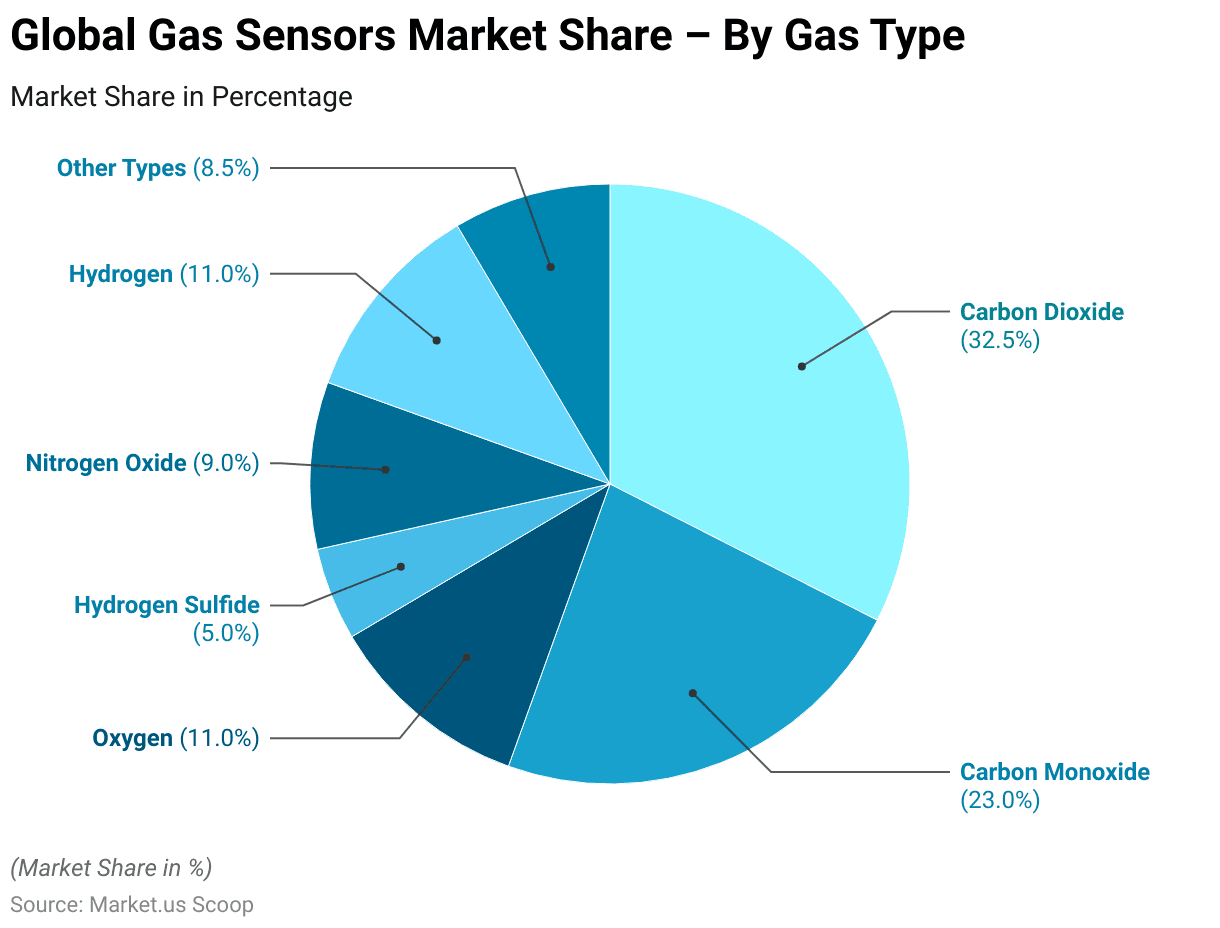Table of Contents
Introduction
Gas Sensors Statistics: Gas sensors detect and measure specific gases in diverse environments using principles like chemical reactions, physical adsorption, and optical absorption.
Types include electrochemical, catalytic, infrared, semiconductor, and photoionization detectors, each tailored to specific gas types and applications.
Electrochemical sensors offer sensitivity and low power usage for portability, while catalytic sensors excel in industrial settings detecting combustible gases.
Infrared sensors identify gases like carbon dioxide, semiconductor sensors are versatile and cost-effective, and photoionization detectors specialize in volatile organic compound detection.
Widely used in industrial safety, environmental monitoring, automotive emissions control, healthcare, and indoor air quality assessment.
Gas sensors significantly contribute to safety, efficiency, and environmental preservation. Key selection factors include target gases, detection range, environmental conditions, response time, and cost-effectiveness.

Editor’s Choice
- The global gas sensors market revenue reached USD 2,748 million in 2023.
- By 2032, wireless gas sensors are forecasted to contribute USD 2,492 million to the market. Surpassing wired sensors’ revenue of USD 2,810 million.
- Carbon dioxide dominates the gas landscape with a commanding market share of 32.5%. Followed closely by carbon monoxide at 23.0%.
- A 0% LEL indicates an absence of combustible gas. While a 100% LEL signifies that the gas concentration is at its lower explosive limit.
- The MQ2 gas sensor is a prominent member of the MQ sensor series. It is widely employed due to its Metal Oxide Semiconductor (MOS) type and its reliance on Chemiresistors. Where gas detection hinges on changes in material resistance upon gas exposure.
- The MQ-7 sensor is designed to detect carbon monoxide (CO) levels in the air. With a detection range of 10 to 500 parts per million (ppm).
- Proper CO2 monitoring indoors not only enhances cognitive functions but also reduces airborne diseases. One popular solution for IAQ and the HVAC industry is the CozIR®-LP2 CO2 Sensor. It is known for its low power consumption and extended lifespan.

Global Gas Sensors Market Statistics
Gas Sensors Market Size Statistics
- The global gas sensors market has shown consistent growth in revenue over the years at a CAGR of 7.80%. Reflecting increasing demand and adoption across various industries.
- In 2022, the market revenue stood at USD 2,549 million. Which grew to USD 2,748 million in 2023 and further to USD 2,934 million in 2024.
- The upward trajectory continues with projected revenues of USD 3,223 million in 2025, USD 3,508 million in 2026, and USD 3,746 million in 2027.
- The growth trend persists through 2028, with revenue reaching USD 3,926 million and continuing to climb to USD 4,232 million in 2029 and USD 4,519 million in 2030.
- By 2031, the market revenue is forecasted to reach USD 4,872 million, further escalating to USD 5,302 million in 2032.
- These figures underscore the increasing importance of gas sensors in ensuring safety, efficiency, and environmental monitoring across industries worldwide.
(Source: Market.us)
Take advantage of our unbeatable offer - buy now!


Gas Sensors Market Size – By Product Type Statistics
- The global gas sensors market has demonstrated steady growth over the past decade. With revenues reaching USD 2,549 million in 2022 and projected to rise consistently, reaching USD 5,302 million by 2032.
- This growth trajectory is fueled by increasing demand for both wired and wireless gas sensors across various industries such as oil and gas, automotive, healthcare, and environmental monitoring.
- In 2022, wired gas sensors accounted for USD 1,351 million in revenue, while wireless sensors generated USD 1,198 million.
- However, the wireless segment is expected to experience faster growth, outpacing wired sensors in revenue by 2030.
- This trend reflects advancements in wireless technology, enabling greater flexibility, scalability, and cost-effectiveness in sensor deployments.
- By 2032, wireless gas sensors are forecasted to contribute USD 2,492 million to the market. Surpassing wired sensors’ revenue of USD 2,810 million.
- Such projections underscore the shift towards IoT-enabled solutions and the growing emphasis on remote monitoring and real-time data analytics across industries.
(Source: Market.us)

Global Gas Sensors Market Size – By Gas Type Statistics
- In the global gas sensors market, various gas types exhibit distinct market shares. Reflecting their significance in industrial, commercial, and residential applications.
- Carbon dioxide dominates the landscape with a commanding market share of 32.5%. Followed closely by carbon monoxide at 23.0%. These gases are pivotal in environmental monitoring, combustion processes, and safety applications.
- Oxygen and hydrogen hold notable shares of 11.0% each. Which is crucial for applications ranging from medical devices to industrial processes.
- Hydrogen sulfide and nitrogen oxide contribute 5.0% and 9.0%, respectively, reflecting their importance in detecting potentially hazardous environments.
- Additionally, hydrogen, with an 11.0% share, plays a significant role in fuel cells and hydrogen-powered vehicles.
- The remaining 8.5% is attributed to other gas types, highlighting the diverse array of gases monitored by gas sensors, including volatile organic compounds and flammable gases.
- This distribution underscores the multifaceted nature of gas sensing technology and its pivotal role in ensuring safety, efficiency, and environmental compliance across various sectors.

Technical Specifications of Gas Sensors Statistics
Combustible Gas
- The Lower Explosive Limit (LEL) or Lower Flammable Limit (LFL) of a combustible gas represents the minimum concentration of the gas needed to sustain a flame when mixed with air or oxygen and ignited. In gas detection systems, gas concentration is typically measured as a percentage (%) of LEL.
- A 0% LEL indicates an absence of combustible gas. While a 100% LEL signifies that the gas concentration is at its lower explosive limit.
- The relationship between percent LEL and percent by volume varies depending on the gas. Trace concentrations are expressed in parts per million (ppm) or parts per billion (ppb). With 1% exposure equivalent to 10,000 ppm or 10,000,000 ppb.
- Combustible gas-air mixtures can catch fire across a broad range of concentrations. Typically from around 0.5% to 15% by volume in the air for common hydrocarbons. This concentration is consistently referred to as 100% LEL or LFL for the gas.
(Source: GlobalSpec)
Electrical Outputs
- Analog voltage outputs usually have a direct, linear correlation with the measured value. Frequency or modulated frequency outputs include different types like frequency modulation (FM), amplitude modulation (AM), sine waves, and pulse trains.
- Analog current levels, such as 4 – 20 mA transmitters, are well-suited for transmitting signals across long distances.
- They work by applying a current to the output circuit in proportion to the measurement. Feedback ensures consistent current supply regardless of line noise and impedance.
(Source: GlobalSpec)
Well-known Gas Sensors and their Applications Statistics
MQ-2 Flammable Gas and Smoke Sensor Module
- The MQ2 gas sensor, a prominent member of the MQ sensor series, is widely employed due to its Metal Oxide Semiconductor (MOS) type and its reliance on Chemiresistors, where gas detection hinges on changes in material resistance upon gas exposure.
- Gas concentration detection is facilitated via a voltage divider network. This versatile sensor can detect various gases, including LPG, alcohol, propane, hydrogen, CO, and methane.
- It features a module version with a Digital Pin for standalone operation without a microcontroller, simplifying single gas detection tasks. For gas measurement in ppm, the analog pin is utilized, which operates at 5V TTL and is compatible with most microcontrollers.
- Operating on 5V DC, the MQ2 sensor consumes approximately 800mW power and detects concentrations of alcohol, propane, LPG, smoke, hydrogen, methane, and carbon monoxide ranging from 200 ppm to 10000 ppm.
(Source: Hatchnhack Cart)
MQ-3 Alcohol Detector Gas Sensor Module
- The MQ-3 module utilizes SnO2 as its sensitive substance to detect alcohol, benzene, CH4, hexane, LPG, and CO, displaying lower conductivity in clean air.
- In the presence of alcohol gas, the sensor’s conductivity increases relative to the gas concentration, showcasing a notable sensitivity to alcohol while remaining resistant to fuel, smoke, and mist.
- It generates an analog resistive output, with heightened alcohol concentrations resulting in decreased resistance across points A and B.
- This resistance alteration creates a voltage divider with the load resistor, yielding higher voltage readings as sensor resistance diminishes.
- Operating at 5V DC and consuming approximately 800mW, the MQ-3 sensor can identify alcohol concentrations ranging from 25 ppm to 500 ppm.
(Source: Hatchnhack Cart)
MQ-4 Methane Gas Sensor Module
- The MQ-4 module is specially made to detect Methane and CNG Gas.
- It runs on 5V DC power and uses about 750mW of electricity.
- This sensor can pick up methane and natural gas levels ranging from 300 to 10,000 parts per million (ppm).
- It’s housed in a casing crafted from plastic and stainless steel netting, and inside. You’ll find components like a measuring electrode, a micro AL2O3 ceramic tube, a Tin Dioxide (SnO2) sensitive layer, and a heater.
- The heater’s job is to make sure all the sensitive parts work perfectly. When you get the wrapped version of the MQ-4 module, you’ll notice it has six pins – four for fetching signals and two for providing power to the heater.
(Source: Hatchnhack Cart)
MQ-135 Air Quality and Hazardous Gas Sensor Module
- The MQ-135 is an air quality sensor capable of detecting various chemicals in the air and adjusting the voltage output accordingly.
- It can identify substances like alcohol, benzene, smoke, NH3, butane, and propane, among others.
- When chemical concentrations increase, the sensor converts this information into a voltage range compatible with Arduino or any microcontroller for processing. However, it cannot specify which chemicals have increased in concentration.
- If you need a sensor to detect common air quality gases such as smoke like CO2, NH3, NOx, alcohol, or benzene, the MQ-135 sensor might be just what you’re looking for.
- It functions as a gas-leakage detector, using SnO2, which naturally has higher resistance in clean air. As the levels of harmful gases increase, the sensor’s resistance decreases accordingly.
(Source: Hatchnhack Cart)
MQ-7 Carbon Monoxide Gas Sensor Module
- The MQ-7 sensor is designed to detect carbon monoxide (CO) levels in the air, with a detection range of 10 to 500 parts per million (ppm).
- It boasts excellent sensitivity and quick response time, providing analog resistance as output.
- Operating temperatures range from –10 to 50°C, and it consumes less than 150 milliamps at 5 volts. The sensor’s preset board allows easy adjustment of the threshold level for digital output.
- It interfaces seamlessly with microcontrollers, Arduino, and other devices.
- Additionally, the MQ-7 sensor can detect various CO-containing gases and is a cost-effective module suitable for diverse applications.
- By using a potentiometer, the sensitivity of the MQ-7 can be easily adjusted.
(Source: Hatchnhack Cart)
Applications of Gas Sensors Statistics
Safety Industries
- Gas detection and monitoring play a vital role in safeguarding individuals working in hazardous environments where dangerous gases may be present.
- The core of any gas detector lies a specialized gas sensor designed to continuously monitor and measure gas concentrations, alerting to elevated levels for enhanced safety.
- For instance, the S8 5% CO2 Sensor serves as a crucial safety measure in various settings. Like agriculture facilities, industrial plants, restaurants, and dry ice storage, functioning as an alarm system to ensure prompt response to CO2 levels beyond the norm.
(Source: CO2Meter)
Indoor Air Quality/HVAC Industries
- Gas sensor technologies are widely utilized in monitoring indoor air quality (IAQ), covering various enclosed spaces. Like homes, offices, classrooms, gyms, and assisted living facilities.
- These sensors not only serve as early warning indicators for rising CO2 levels but also contribute to energy efficiency and HVAC system longevity.
- Proper CO2 monitoring indoors not only enhances cognitive functions but also reduces airborne diseases. One popular solution for IAQ and the HVAC industry is the CozIR®-LP2 CO2 Sensor, known for its low power consumption and extended lifespan.
- Additionally, it finds application in Demand Control Ventilation (DCV) systems due to its compatibility with small batteries, solar panels, and other energy harvesting devices. Another notable option is the Aranet4 PRO Indoor Air Quality Monitor.
(Source: CO2Meter)
Medical and Life-Science Industries
- Gas sensing technologies are extensively utilized in the medical and life sciences sectors due to their exceptional accuracy, reliability, and consistency.
- These sensors find integration in various areas, including incubation, neuroscience, respiration, and capnography, among others.
- CO2Meter collaborates with esteemed institutions like the University of California Berkeley. Which relies on SprintIR6S 20% CO2 Smart Sensor for its ability to capture highly accurate data at 20 times per second for medical research purposes.
- Another valuable application involves the use of Incubator CO2 Sensors to monitor CO2 levels in biological cell incubators, ensuring optimal conditions for cell and tissue growth.
(Source: CO2Meter)
Aerospace Industries
- Gas sensor technologies play a crucial role in the aerospace industry, particularly in measuring oxygen and carbon dioxide concentrations.
- These sensors are essential for monitoring in-flight conditions and maintaining air quality to ensure crew productivity and passenger comfort.
- An intriguing study conducted as part of the National University Capstone Project focused on oxygen safety masks, utilizing CM-42951 0-25% UV Flux Oxygen Smart Sensor.
- This sensor enabled aerospace researchers to accurately measure oxygen concentrations passing through an F-35 Lightning II Pilot Mask.
(Source: CO2Meter)
Industrial Applications
- Customers often look for gas sensor technologies suitable for tough industrial environments. It’s essential to choose a sensor that can withstand harsh conditions.
- For example, the ExplorIR®-W CO2 Sensor can accurately measure up to 100% CO2 concentrations in environments with high vibration and humidity.
- Additionally, the Oxy-Flex Oxygen Analyzer is ideal for monitoring combustion processes like optimizing boiler efficiency and measuring oxygen levels.
(Source: CO2Meter)
Recent Developments
Acquisitions and Mergers:
- SensorTech Inc. acquired GasDetection Solutions for $150 million, consolidating its position in the gas sensor market and expanding its product offerings.
- Environmental Sensing Group merged with GasTech Innovations, forming a strategic partnership to advance gas sensing technologies for environmental monitoring, with combined expertise in sensor development and data analytics.
New Product Launches:
- SensiProbe introduced a compact gas sensor for indoor air quality monitoring, offering real-time detection of volatile organic compounds (VOCs) and hazardous gases, aiming to capture 20% of the indoor air quality sensor market within the first year.
- GasGuard launched a wearable sensor like a wearable gas sensor for personal safety applications, providing continuous monitoring of toxic gases and alerting users to potential hazards, targeting 50,000 units sold within six months.
Funding Rounds:
- GasSense received $20 million in Series A funding led by CleanTech Investors to expand their gas sensor manufacturing capacity and invest in research initiatives for next-generation sensor technologies, aiming for a 50% increase in production volume within two years.
- SensorTech secured $10 million in seed funding from Venture Capital Firm to develop innovative gas sensing solutions for industrial applications and establish partnerships with major manufacturers, targeting a 40% growth in revenue over the next fiscal year.
Consumer Trends:
- Rising concerns about air pollution and workplace safety fueled the demand for gas sensors, with sales of portable gas detectors increasing by 15% compared to the previous year.
- Smart gas sensors witnessed a 20% growth in adoption, reflecting increasing interest in IoT-enabled sensor networks for remote monitoring and predictive maintenance applications.
Regulatory Landscape:
- Regulatory agencies implemented standards for gas sensor performance and calibration, ensuring accuracy and reliability in gas detection systems used for safety and environmental monitoring purposes.
Investment in Research and Development:
- Sensor manufacturers and technology firms allocated substantial resources to gas sensor research and development, with an estimated $2 billion invested globally in sensor technology advancements and market expansion initiatives.
Conclusion
Gas Sensors Statistics – In conclusion, gas sensors are vital across diverse industries. From ensuring industrial safety to monitoring environmental conditions and indoor air quality.
These sensors employ various principles to detect gases accurately, offering unique benefits tailored to different applications.
The global market for gas sensors is expanding due to safety regulations, technological advancements, and environmental awareness.
As industries prioritize safety and efficiency, demand for reliable gas-sensing solutions grows. Selecting the right sensor is crucial, considering factors like target gases, detection range, and cost-effectiveness to ensure optimal performance and safety.
FAQs
Gas sensors are devices designed to detect and measure the presence and concentration of specific gases in the surrounding environment.
Gas sensors operate on various principles, including chemical reactions, physical adsorption, and optical absorption. When a targeted gas interacts with the sensor’s sensing material, it produces a measurable change. Such as a shift in electrical conductivity or optical properties, which the sensor then detects and quantifies.
Gas sensors come in various types, including electrochemical, catalytic, infrared, semiconductor, and photoionization detectors, each tailored to specific applications and gas types.
Gas sensors are used in a wide range of applications, including industrial safety, environmental monitoring, automotive emissions control, healthcare, indoor air quality assessment, and more.
The frequency of calibration depends on factors such as the sensor type, environmental conditions, and the manufacturer’s recommendations. Generally, gas sensors may require periodic calibration to maintain accuracy and reliability.
Discuss your needs with our analyst
Please share your requirements with more details so our analyst can check if they can solve your problem(s)



